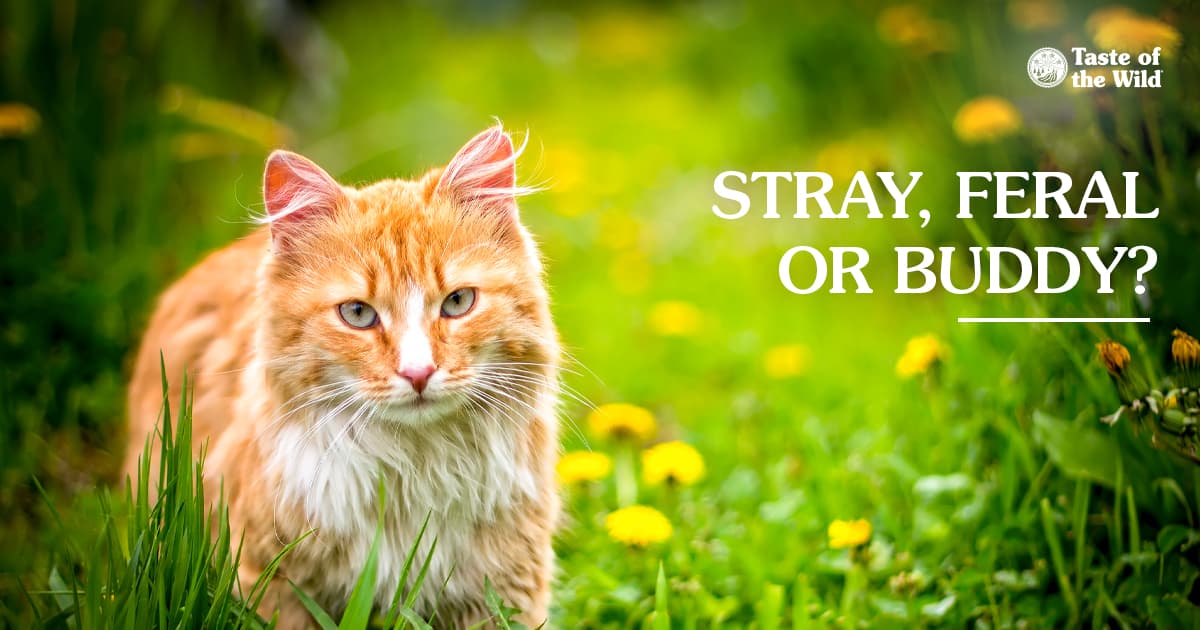
The latest package delivery has shown up on your doorstep … and so has a cat? A puzzled look appears across your face and you have a thought. Did someone’s cat get out?
Well, not necessarily. This could be a lost pet looking for its owner, but it could also be a stray or a feral feline. Knowing the difference between each can help determine the best way to interact with the cat and what, if any, intervention would be appropriate.
Feral Cat Characteristics
- Unsocialized felines who keep their distance and are quite skittish when they see you
- Know how to live on the streets or in the wild and likely have a permanent place they shelter in the neighborhood
- Will likely crouch low to the ground, protect themselves with their tail and avoid eye contact
- Keep their distance and do not roam too close to people or buildings
- When you say hello, you won’t hear a meow or purr in response
- Do not often wander around during the day
- They may look undernourished or have matted fur
- Not a candidate for adoption
Stray Cat Characteristics
- Know how to get by living outside but have been socialized enough for people to pet them
- May come right up to greet you, or may come to you in time
- Tend to be in fair to good physical condition
- When frightened, might act like a feral cat (try to observe the cat on its own terms – not when it’s trapped)
- Might walk around with its tail up — a sign of friendliness
- Will probably make eye contact
- More likely to offer a meow or purr in response to your greeting
- Often seen during the daytime
- Could be a candidate for adoption
Pet Cat Characteristics
- Cats who are lost and looking for their owner will exhibit signs that they have been socialized — including the ability to make eye contact and being OK with human touch
- May sport a collar or might be microchipped
- Appears well fed and in good condition
- May be frantic, looking for their owner
- Likely to meow or purr in response to your greeting
- If you cannot get close enough to read a tag (if they have one), you may be able to find their owner through neighborhood flyers or lost pet groups on Facebook and NextDoor
- Could be a candidate for adoption if you are unable to locate its owner (it’s always best to reunite lost pets with their owners when possible)
A Community of Cats?
It’s important to mention that both feral and stray cats could be part of a colony. Community cats, as they are often called, are humanely trapped, neutered and returned (TNR) to their original location. During the TNR process, the veterinarian surgically removes the top quarter inch of one ear to distinguish which cats have gone through the program.
Community cats control the rodent population in their neighborhood, and they tend to keep untreated, feral cats away. Some cat colonies also have a central human caretaker. When visiting with neighbors about the new cat in your yard, you may discover a colony caretaker nearby.
Community cats have a better chance of survival than feral cats, since they are neutered and vaccinated. Plus, TNR controls overpopulation issues.
If you’ve identified a non-community cat in your yard, and you’d like to learn more about TNR, reach out to your local humane shelter for more information.
RELATED POST: Can an Outdoor Cat Ever Become an Indoor Cat?
The information in this blog has been developed with our veterinarian and is designed to help educate pet parents. If you have questions or concerns about your pet's health or nutrition, please talk with your veterinarian.
